For many years, researchers have been trying to create a durable, low-cost synthetic muscle, but it has never been successful. Samples manufactured to date are either too expensive to be mass-produced (such as carbon nanotubes); either too fragile and too energy intensive (say you, shape memory alloy), so that there is not much practical value. But recently, a research team at MIT used nylon fiber to create an ideal artificial muscle that meets all practical requirements.
According to a report published yesterday by the academic journal Advanced Materials ("Advanced Materials"), the secret of this technology lies in the shape and heating of the fibers. Nylon fibers have a magical characteristic that they shrink in length and increase in diameter as you heat them. This makes nylon fiber an ideal material for linear motion, such as lifting something upright. But it is not that simple to bend nylon fibers while shrinking.

In the conventional method, the pulley device is required to bend the nylon. This adds to the weight, complexity and cost of the system – they are exactly the three things that need to be reduced in mass production of new technologies.
The MIT team found a clever way to get around this problem. The team used ordinary nylon yarn. They first compress it and change the circular cross section to a rectangle. Then they only heat one side of the fiber. In this way, the heated side shrinks faster than the unheated side, forcing the nylon fibers to bend toward the heated side. The heating source can be anything, including resistance heating, chemical reaction heating, and laser heating. These nylon fibers are surprisingly strong and durable, withstand up to 100,000 cycles of use and can shrink 17 times in one second.
Below is a picture of three MIT researchers performing a heating and bending test on the fiber. In the third image, the researchers used laser irradiation to heat the fiber side.



This breakthrough in artificial muscles has a wide range of potential applications in the industrial and commercial sectors. For example, you can automatically shrink according to your body type, extremely fit "smart clothes", and then you don't have to worry about the size of the clothes. These fibers can also be used in cars and airplanes. Remember the Gina concept car launched by BMW earlier this year? The body of this Fantasy sports car is covered with a layer of adjustable, expandable fiber material. With this fiber, the "outerwear" (housing) of the car can automatically change shape when subjected to wind at high speeds, minimizing windage.


BMW Gina Concept Car
This technique can also be applied to automatically adjust the catheter to fight insulin. One day, we will even see this nylon fiber applied to the bionic robot as their muscle. Regrettably, it is still unknown how far this man-made fiber is from marketization.
Cement resistance: is the resistance wire wound on the alkali heat-resistant porcelain, coupled with heat resistant, resistant to wet outside fixed protection and corrosion resistance of the materials and the winding resistance into the square porcelain box body, using special incombustible cement packing seal.The outside of cement resistance is mainly made of ceramic materials (generally divided into high alumina porcelain and feldspar porcelain).
Cement Resistor,Thermal Cement Resistor,Thin Film Cement Resistor,Winding Cement Resistor,Fusing Cement Resistor
YANGZHOU POSITIONING TECH CO., LTD , https://www.yzpstcc.com